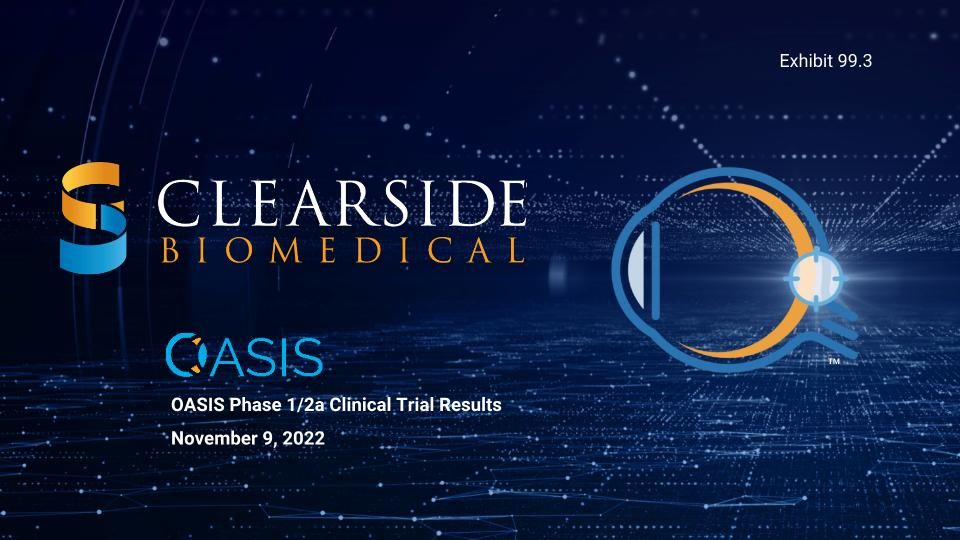
OASIS Phase 1/2a Clinical Trial Results November 9, 2022 TM Exhibit 99.3
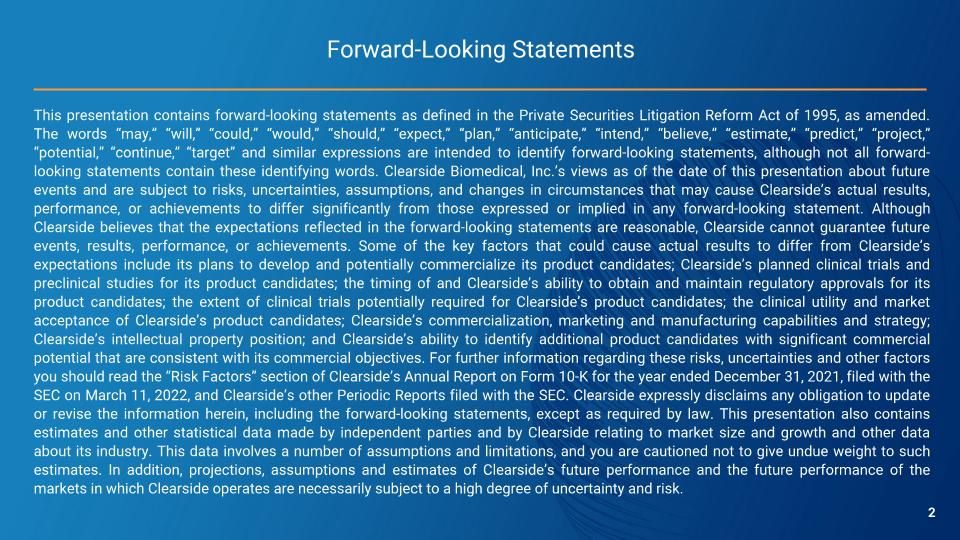
Forward-Looking Statements This presentation contains forward-looking statements as defined in the Private Securities Litigation Reform Act of 1995, as amended. The words “may,” “will,” “could,” “would,” “should,” “expect,” “plan,” “anticipate,” “intend,” “believe,” “estimate,” “predict,” “project,” “potential,” “continue,” “target” and similar expressions are intended to identify forward-looking statements, although not all forward-looking statements contain these identifying words. Clearside Biomedical, Inc.’s views as of the date of this presentation about future events and are subject to risks, uncertainties, assumptions, and changes in circumstances that may cause Clearside’s actual results, performance, or achievements to differ significantly from those expressed or implied in any forward-looking statement. Although Clearside believes that the expectations reflected in the forward-looking statements are reasonable, Clearside cannot guarantee future events, results, performance, or achievements. Some of the key factors that could cause actual results to differ from Clearside’s expectations include its plans to develop and potentially commercialize its product candidates; Clearside’s planned clinical trials and preclinical studies for its product candidates; the timing of and Clearside’s ability to obtain and maintain regulatory approvals for its product candidates; the extent of clinical trials potentially required for Clearside’s product candidates; the clinical utility and market acceptance of Clearside’s product candidates; Clearside’s commercialization, marketing and manufacturing capabilities and strategy; Clearside’s intellectual property position; and Clearside’s ability to identify additional product candidates with significant commercial potential that are consistent with its commercial objectives. For further information regarding these risks, uncertainties and other factors you should read the “Risk Factors” section of Clearside’s Annual Report on Form 10-K for the year ended December 31, 2021, filed with the SEC on March 11, 2022, and Clearside’s other Periodic Reports filed with the SEC. Clearside expressly disclaims any obligation to update or revise the information herein, including the forward-looking statements, except as required by law. This presentation also contains estimates and other statistical data made by independent parties and by Clearside relating to market size and growth and other data about its industry. This data involves a number of assumptions and limitations, and you are cautioned not to give undue weight to such estimates. In addition, projections, assumptions and estimates of Clearside’s future performance and the future performance of the markets in which Clearside operates are necessarily subject to a high degree of uncertainty and risk. 2
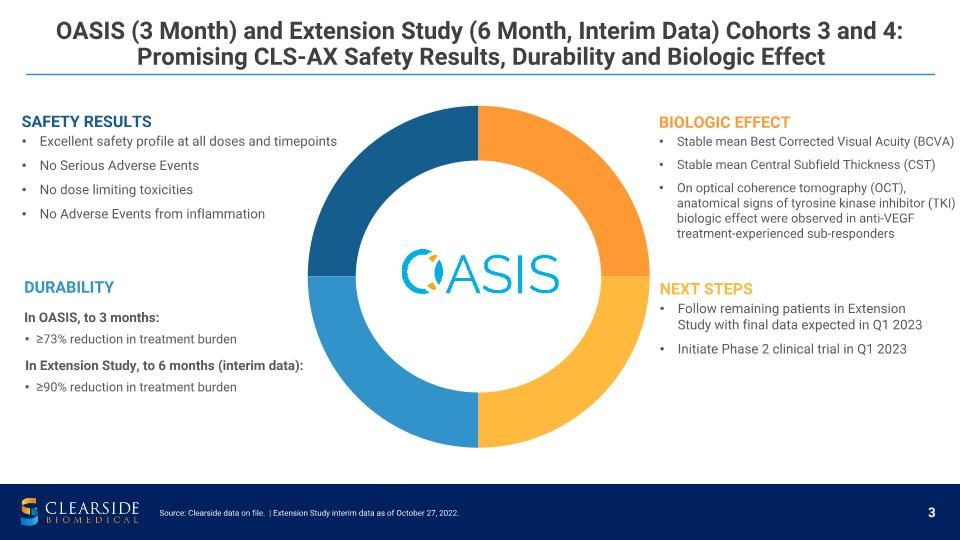
SAFETY RESULTS Excellent safety profile at all doses and timepoints No Serious Adverse Events No dose limiting toxicities No Adverse Events from inflammation Source: Clearside data on file. | Extension Study interim data as of October 27, 2022. BIOLOGIC EFFECT Stable mean Best Corrected Visual Acuity (BCVA) Stable mean Central Subfield Thickness (CST) On optical coherence tomography (OCT), anatomical signs of tyrosine kinase inhibitor (TKI) biologic effect were observed in anti-VEGF treatment-experienced sub-responders NEXT STEPS Follow remaining patients in Extension Study with final data expected in Q1 2023 Initiate Phase 2 clinical trial in Q1 2023 DURABILITY In OASIS, to 3 months: ≥73% reduction in treatment burden In Extension Study, to 6 months (interim data): ≥90% reduction in treatment burden OASIS (3 Month) and Extension Study (6 Month, Interim Data) Cohorts 3 and 4:�Promising CLS-AX Safety Results, Durability and Biologic Effect
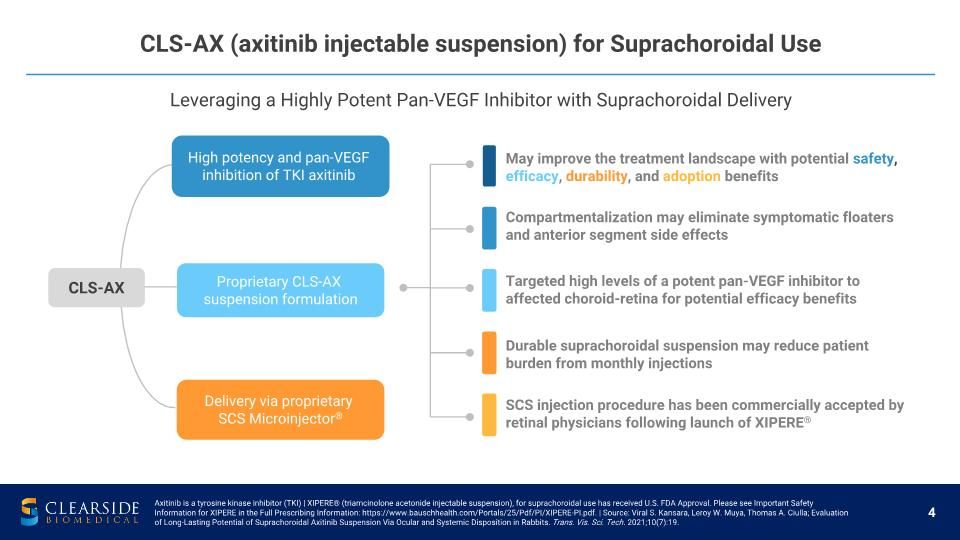
Leveraging a Highly Potent Pan-VEGF Inhibitor with Suprachoroidal Delivery CLS-AX (axitinib injectable suspension) for Suprachoroidal Use May improve the treatment landscape with potential safety, efficacy, durability, and adoption benefits Durable suprachoroidal suspension may reduce patient burden from monthly injections Compartmentalization may eliminate symptomatic floaters and anterior segment side effects Targeted high levels of a potent pan-VEGF inhibitor to affected choroid-retina for potential efficacy benefits SCS injection procedure has been commercially accepted by retinal physicians following launch of XIPERE® Proprietary CLS-AX suspension formulation Delivery via proprietary SCS Microinjector® High potency and pan-VEGF inhibition of TKI axitinib CLS-AX Axitinib is a tyrosine kinase inhibitor (TKI) | XIPERE® (triamcinolone acetonide injectable suspension), for suprachoroidal use has received U.S. FDA Approval. Please see Important Safety Information for XIPERE in the Full Prescribing Information: https://www.bauschhealth.com/Portals/25/Pdf/PI/XIPERE-PI.pdf. | Source: Viral S. Kansara, Leroy W. Muya, Thomas A. Ciulla; Evaluation of Long-Lasting Potential of Suprachoroidal Axitinib Suspension Via Ocular and Systemic Disposition in Rabbits. Trans. Vis. Sci. Tech. 2021;10(7):19.
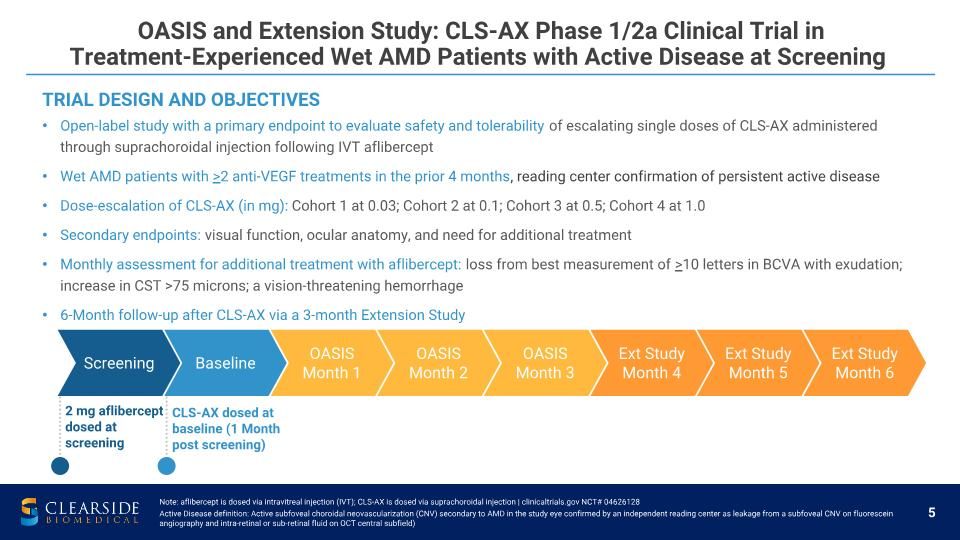
TRIAL DESIGN AND OBJECTIVES Open-label study with a primary endpoint to evaluate safety and tolerability of escalating single doses of CLS-AX administered through suprachoroidal injection following IVT aflibercept Wet AMD patients with >2 anti-VEGF treatments in the prior 4 months, reading center confirmation of persistent active disease Dose-escalation of CLS-AX (in mg): Cohort 1 at 0.03; Cohort 2 at 0.1; Cohort 3 at 0.5; Cohort 4 at 1.0 Secondary endpoints: visual function, ocular anatomy, and need for additional treatment Monthly assessment for additional treatment with aflibercept: loss from best measurement of >10 letters in BCVA with exudation; increase in CST >75 microns; a vision-threatening hemorrhage 6-Month follow-up after CLS-AX via a 3-month Extension Study Screening Baseline 2 mg aflibercept dosed at screening CLS-AX dosed at baseline (1 Month post screening) Note: aflibercept is dosed via intravitreal injection (IVT); CLS-AX is dosed via suprachoroidal injection | clinicaltrials.gov NCT# 04626128 Active Disease definition: Active subfoveal choroidal neovascularization (CNV) secondary to AMD in the study eye confirmed by an independent reading center as leakage from a subfoveal CNV on fluorescein angiography and intra-retinal or sub-retinal fluid on OCT central subfield) OASIS Month 1 OASIS Month 2 Ext Study Month 4 OASIS and Extension Study: CLS-AX Phase 1/2a Clinical Trial in �Treatment-Experienced Wet AMD Patients with Active Disease at Screening OASIS Month 3 Ext Study Month 5 Ext Study Month 6
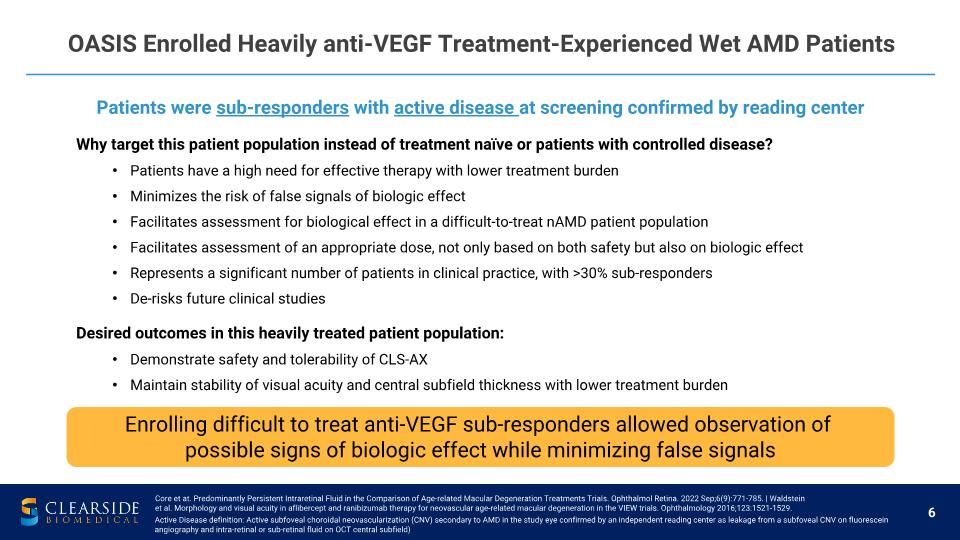
Why target this patient population instead of treatment naïve or patients with controlled disease? Patients have a high need for effective therapy with lower treatment burden Minimizes the risk of false signals of biologic effect Facilitates assessment for biological effect in a difficult-to-treat nAMD patient population Facilitates assessment of an appropriate dose, not only based on both safety but also on biologic effect Represents a significant number of patients in clinical practice, with >30% sub-responders De-risks future clinical studies Desired outcomes in this heavily treated patient population: Demonstrate safety and tolerability of CLS-AX Maintain stability of visual acuity and central subfield thickness with lower treatment burden OASIS Enrolled Heavily anti-VEGF Treatment-Experienced Wet AMD Patients Patients were sub-responders with active disease at screening confirmed by reading center Enrolling difficult to treat anti-VEGF sub-responders allowed observation of possible signs of biologic effect while minimizing false signals Core et at. Predominantly Persistent Intraretinal Fluid in the Comparison of Age-related Macular Degeneration Treatments Trials. Ophthalmol Retina. 2022 Sep;6(9):771-785. | Waldstein et al. Morphology and visual acuity in aflibercept and ranibizumab therapy for neovascular age-related macular degeneration in the VIEW trials. Ophthalmology 2016;123:1521-1529. Active Disease definition: Active subfoveal choroidal neovascularization (CNV) secondary to AMD in the study eye confirmed by an independent reading center as leakage from a subfoveal CNV on fluorescein angiography and intra-retinal or sub-retinal fluid on OCT central subfield)
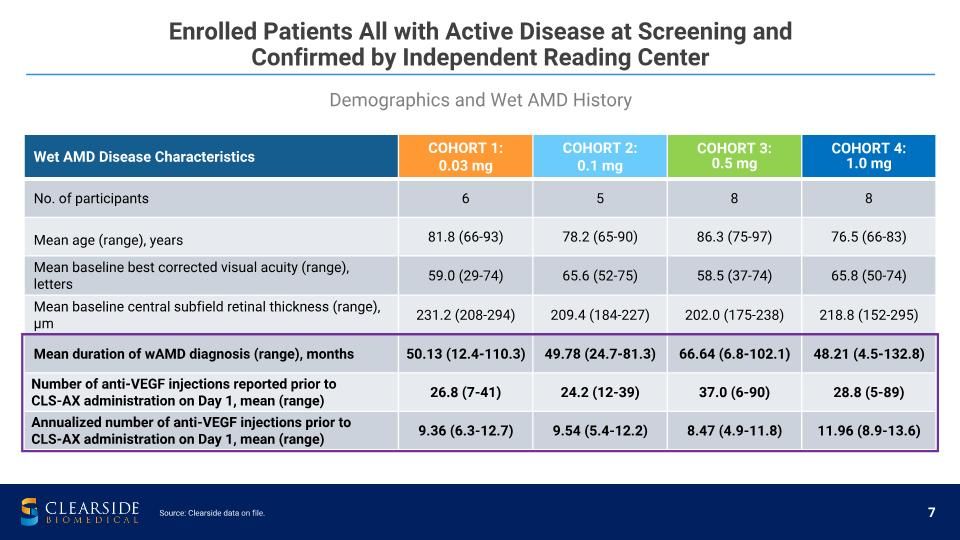
Wet AMD Disease Characteristics COHORT 1: 0.03 mg COHORT 2: 0.1 mg COHORT 3: 0.5 mg COHORT 4: 1.0 mg No. of participants 6 5 8 8 Mean age (range), years 81.8 (66-93) 78.2 (65-90) 86.3 (75-97) 76.5 (66-83) Mean baseline best corrected visual acuity (range), letters 59.0 (29-74) 65.6 (52-75) 58.5 (37-74) 65.8 (50-74) Mean baseline central subfield retinal thickness (range), µm 231.2 (208-294) 209.4 (184-227) 202.0 (175-238) 218.8 (152-295) Mean duration of wAMD diagnosis (range), months 50.13 (12.4-110.3) 49.78 (24.7-81.3) 66.64 (6.8-102.1) 48.21 (4.5-132.8) Number of anti-VEGF injections reported prior to CLS-AX administration on Day 1, mean (range) 26.8 (7-41) 24.2 (12-39) 37.0 (6-90) 28.8 (5-89) Annualized number of anti-VEGF injections prior to CLS-AX administration on Day 1, mean (range) 9.36 (6.3-12.7) 9.54 (5.4-12.2) 8.47 (4.9-11.8) 11.96 (8.9-13.6) Demographics and Wet AMD History Enrolled Patients All with Active Disease at Screening and �Confirmed by Independent Reading Center Source: Clearside data on file.
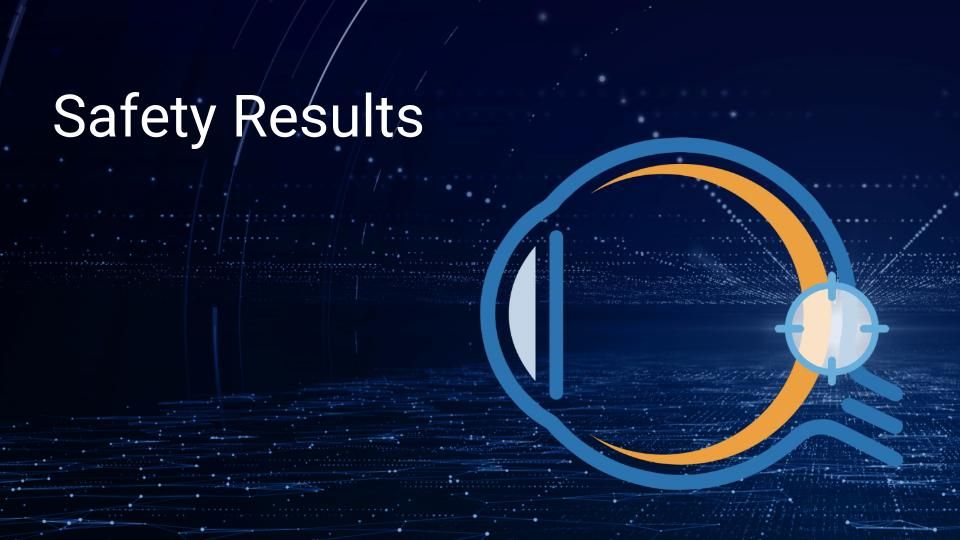
Safety Results
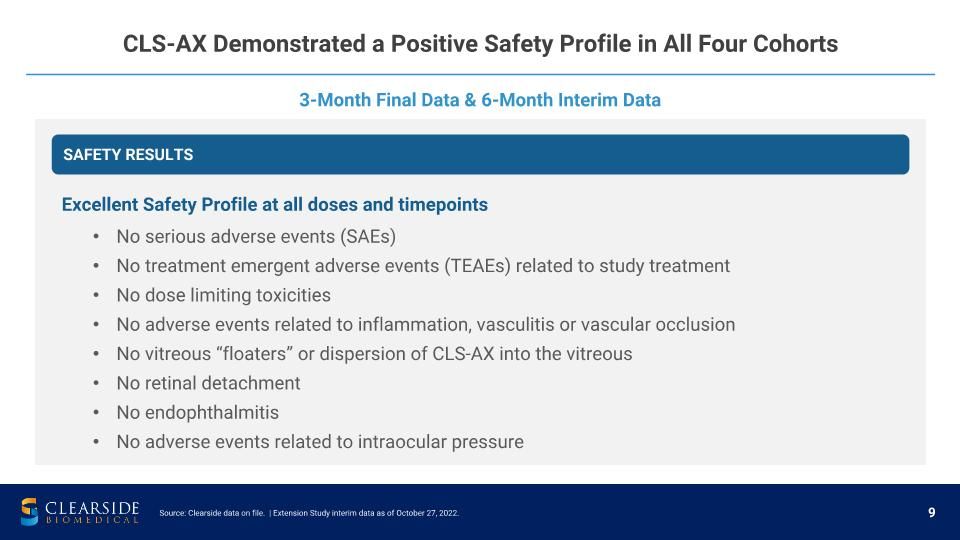
3-Month Final Data & 6-Month Interim Data CLS-AX Demonstrated a Positive Safety Profile in All Four Cohorts Excellent Safety Profile at all doses and timepoints No serious adverse events (SAEs) No treatment emergent adverse events (TEAEs) related to study treatment No dose limiting toxicities No adverse events related to inflammation, vasculitis or vascular occlusion No vitreous “floaters” or dispersion of CLS-AX into the vitreous No retinal detachment No endophthalmitis No adverse events related to intraocular pressure SAFETY RESULTS Source: Clearside data on file. | Extension Study interim data as of October 27, 2022.
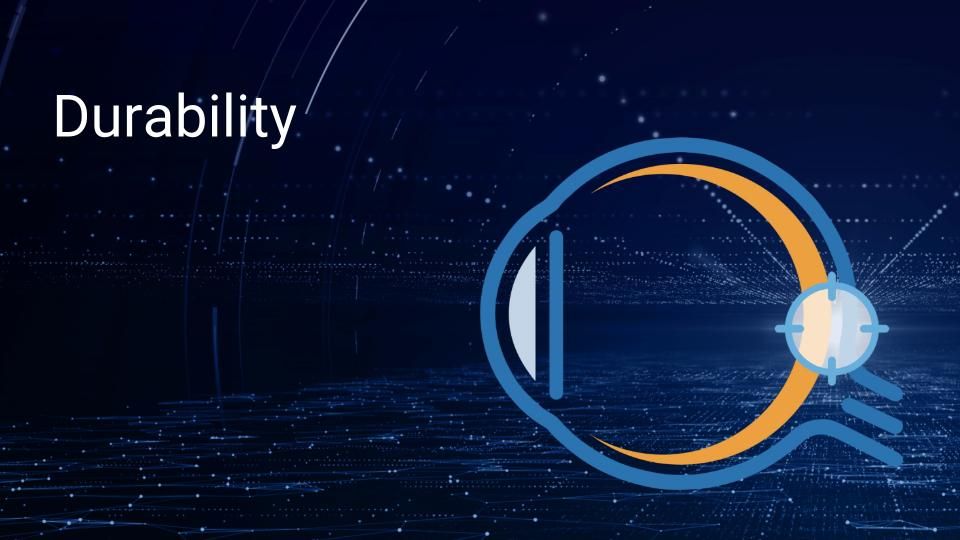
Durability
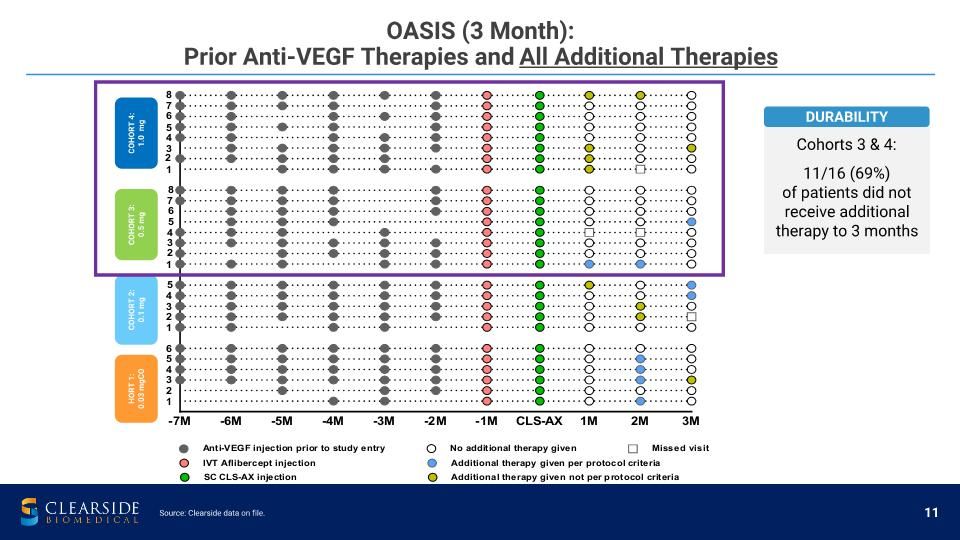
HORT 1: 0.03 mgCO COHORT 2: 0.1 mg COHORT 3: 0.5 mg COHORT 4: 1.0 mg Source: Clearside data on file. OASIS (3 Month):�Prior Anti-VEGF Therapies and All Additional Therapies Cohorts 3 & 4: 11/16 (69%) of patients did not receive additional therapy to 3 months DURABILITY
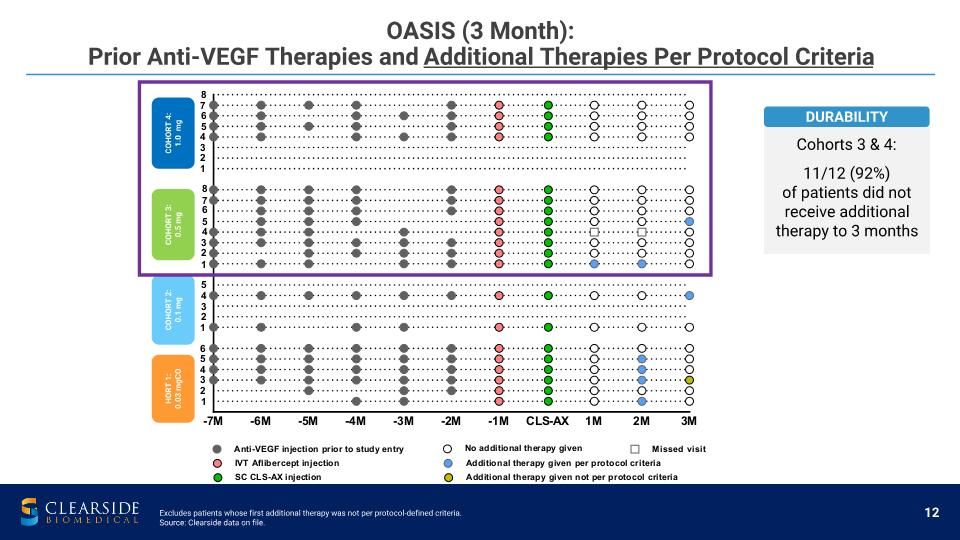
HORT 1: 0.03 mgCO COHORT 2: 0.1 mg COHORT 3: 0.5 mg COHORT 4: 1.0 mg Excludes patients whose first additional therapy was not per protocol-defined criteria. Source: Clearside data on file. OASIS (3 Month):�Prior Anti-VEGF Therapies and Additional Therapies Per Protocol Criteria Cohorts 3 & 4: 11/12 (92%) of patients did not receive additional therapy to 3 months DURABILITY
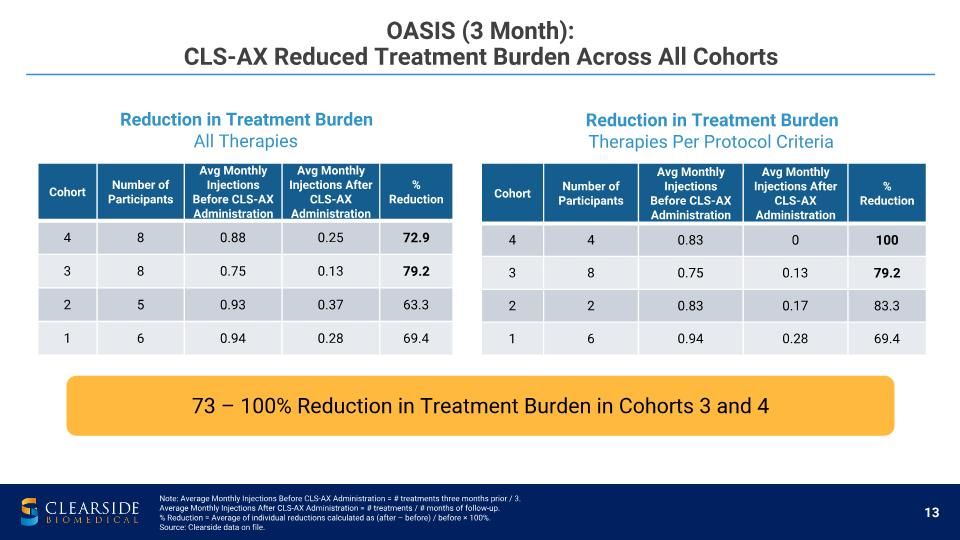
OASIS (3 Month):�CLS-AX Reduced Treatment Burden Across All Cohorts Cohort Number of Participants Avg Monthly Injections Before CLS-AX Administration Avg Monthly Injections After CLS-AX Administration % Reduction 4 8 0.88 0.25 72.9 3 8 0.75 0.13 79.2 2 5 0.93 0.37 63.3 1 6 0.94 0.28 69.4 Reduction in Treatment Burden All Therapies Cohort Number of Participants Avg Monthly Injections Before CLS-AX Administration Avg Monthly Injections After CLS-AX Administration % Reduction 4 4 0.83 0 100 3 8 0.75 0.13 79.2 2 2 0.83 0.17 83.3 1 6 0.94 0.28 69.4 Note: Average Monthly Injections Before CLS-AX Administration = # treatments three months prior / 3. Average Monthly Injections After CLS-AX Administration = # treatments / # months of follow-up. % Reduction = Average of individual reductions calculated as (after – before) / before × 100%. Source: Clearside data on file. Reduction in Treatment Burden Therapies Per Protocol Criteria 73 – 100% Reduction in Treatment Burden in Cohorts 3 and 4
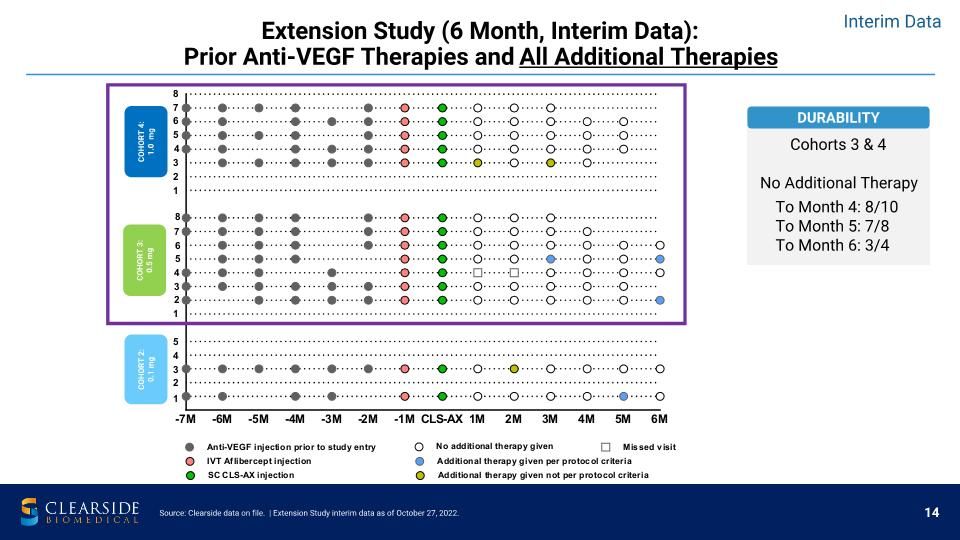
Extension Study (6 Month, Interim Data): �Prior Anti-VEGF Therapies and All Additional Therapies COHORT 2: 0.1 mg COHORT 3: 0.5 mg COHORT 4: 1.0 mg Source: Clearside data on file. | Extension Study interim data as of October 27, 2022. Cohorts 3 & 4 No Additional Therapy To Month 4: 8/10 To Month 5: 7/8 To Month 6: 3/4 DURABILITY Interim Data
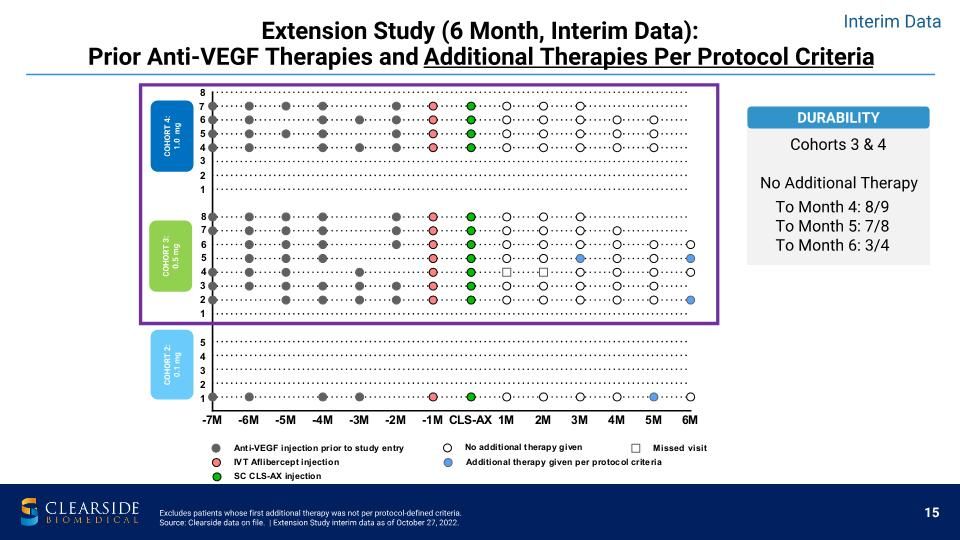
Extension Study (6 Month, Interim Data):�Prior Anti-VEGF Therapies and Additional Therapies Per Protocol Criteria COHORT 2: 0.1 mg COHORT 3: 0.5 mg COHORT 4: 1.0 mg Excludes patients whose first additional therapy was not per protocol-defined criteria. Source: Clearside data on file. | Extension Study interim data as of October 27, 2022. Cohorts 3 & 4 No Additional Therapy To Month 4: 8/9 To Month 5: 7/8 To Month 6: 3/4 DURABILITY Interim Data
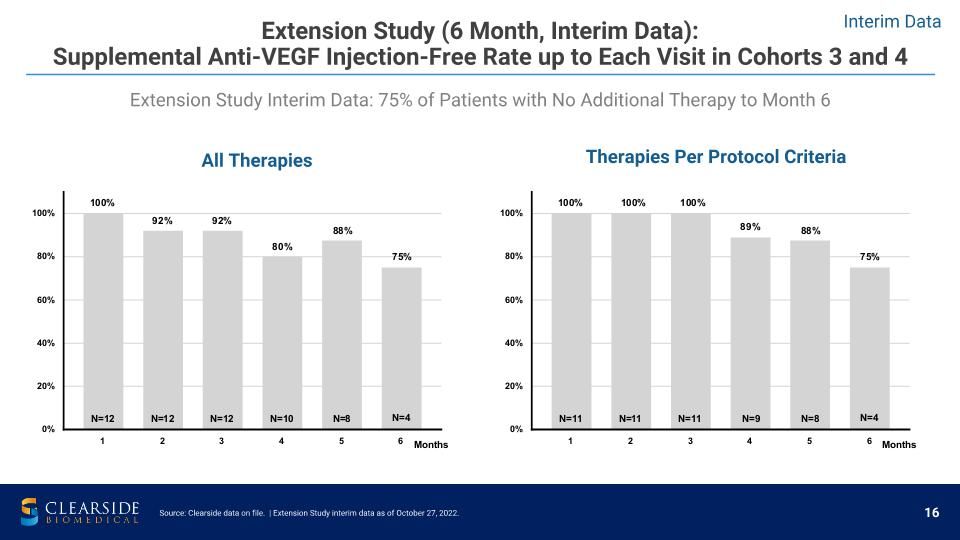
Extension Study Interim Data: 75% of Patients with No Additional Therapy to Month 6 Extension Study (6 Month, Interim Data):�Supplemental Anti-VEGF Injection-Free Rate up to Each Visit in Cohorts 3 and 4 Source: Clearside data on file. | Extension Study interim data as of October 27, 2022. Interim Data Therapies Per Protocol Criteria All Therapies
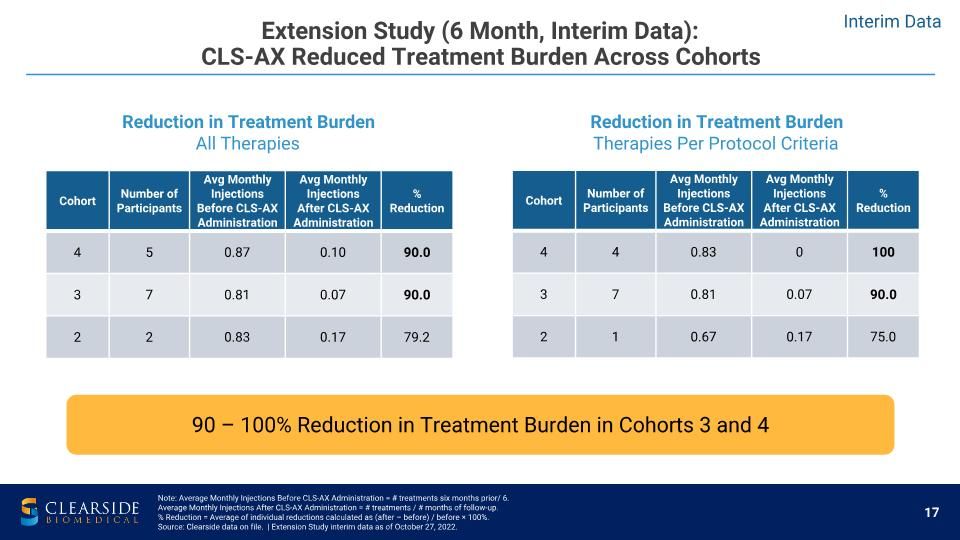
Extension Study (6 Month, Interim Data):�CLS-AX Reduced Treatment Burden Across Cohorts Reduction in Treatment Burden All Therapies Reduction in Treatment Burden Therapies Per Protocol Criteria Cohort Number of Participants Avg Monthly Injections Before CLS-AX Administration Avg Monthly Injections After CLS-AX Administration % Reduction 4 4 0.83 0 100 3 7 0.81 0.07 90.0 2 1 0.67 0.17 75.0 90 – 100% Reduction in Treatment Burden in Cohorts 3 and 4 Cohort Number of Participants Avg Monthly Injections Before CLS-AX Administration Avg Monthly Injections After CLS-AX Administration % Reduction 4 5 0.87 0.10 90.0 3 7 0.81 0.07 90.0 2 2 0.83 0.17 79.2 Note: Average Monthly Injections Before CLS-AX Administration = # treatments six months prior/ 6. Average Monthly Injections After CLS-AX Administration = # treatments / # months of follow-up. % Reduction = Average of individual reductions calculated as (after – before) / before × 100%. Source: Clearside data on file. | Extension Study interim data as of October 27, 2022. Interim Data
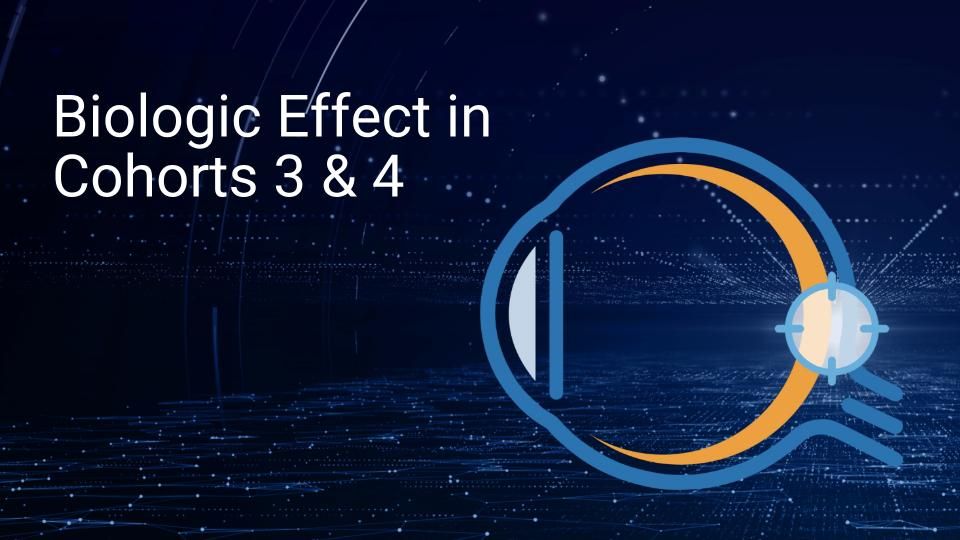
Biologic Effect in Cohorts 3 & 4
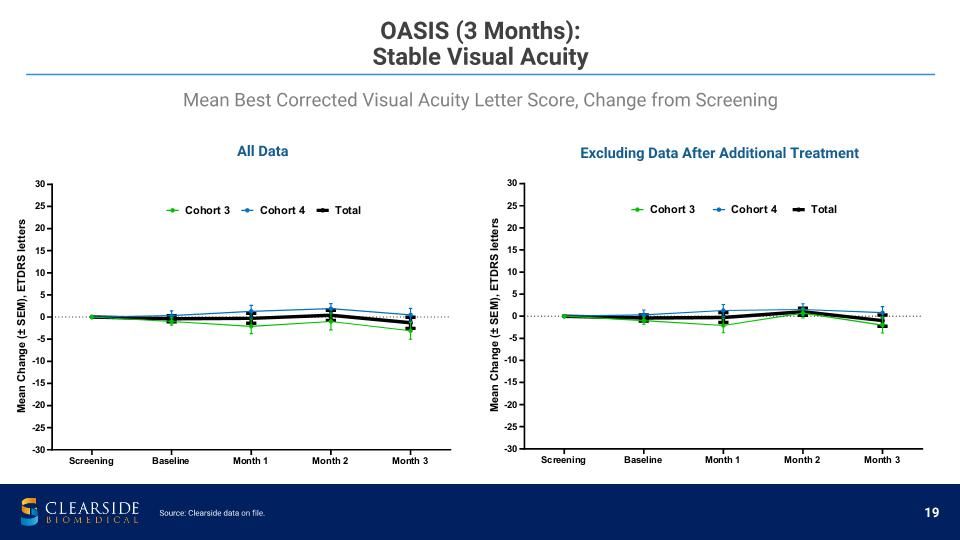
Mean Best Corrected Visual Acuity Letter Score, Change from Screening OASIS (3 Months):�Stable Visual Acuity Source: Clearside data on file. All Data Excluding Data After Additional Treatment
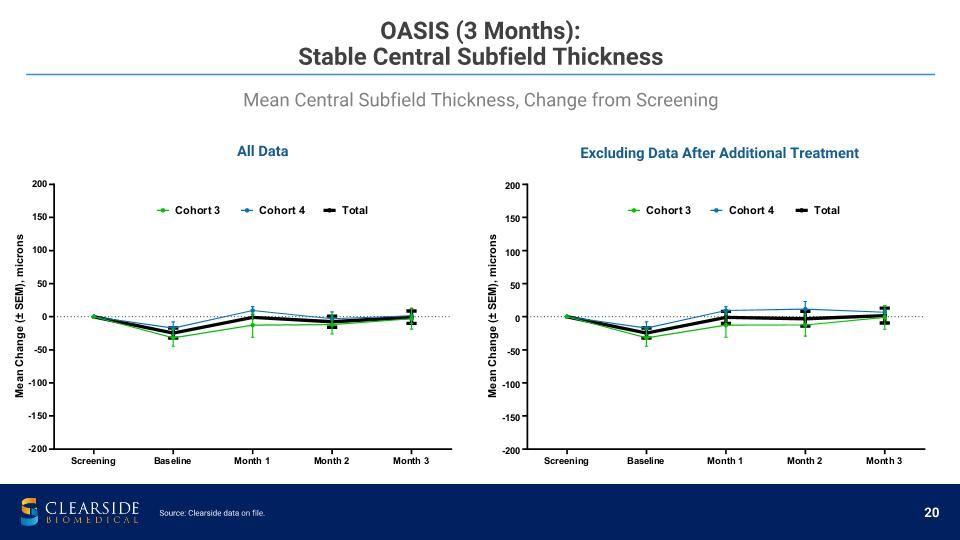
Mean Central Subfield Thickness, Change from Screening OASIS (3 Months):�Stable Central Subfield Thickness Source: Clearside data on file. All Data Excluding Data After Additional Treatment
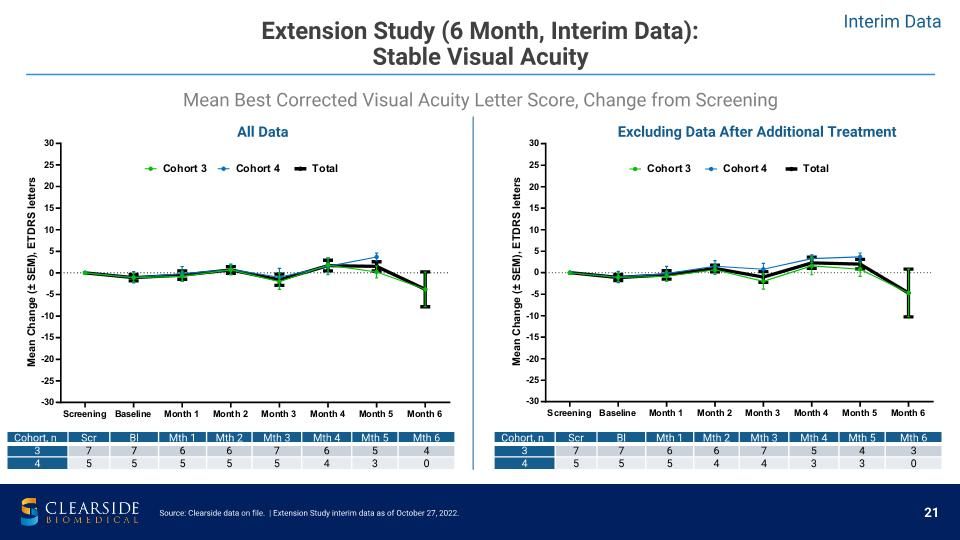
Mean Best Corrected Visual Acuity Letter Score, Change from Screening Extension Study (6 Month, Interim Data):�Stable Visual Acuity All Data Excluding Data After Additional Treatment Source: Clearside data on file. | Extension Study interim data as of October 27, 2022. Cohort, n Scr Bl Mth 1 Mth 2 Mth 3 Mth 4 Mth 5 Mth 6 3 7 7 6 6 7 6 5 4 4 5 5 5 5 5 4 3 0 Interim Data Cohort, n Scr Bl Mth 1 Mth 2 Mth 3 Mth 4 Mth 5 Mth 6 3 7 7 6 6 7 5 4 3 4 5 5 5 4 4 3 3 0
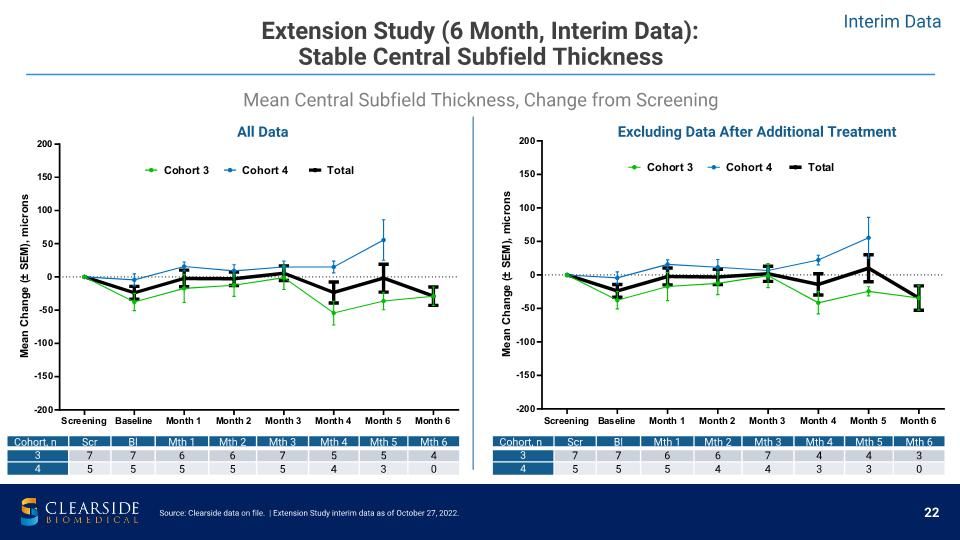
Mean Central Subfield Thickness, Change from Screening Extension Study (6 Month, Interim Data):�Stable Central Subfield Thickness Source: Clearside data on file. | Extension Study interim data as of October 27, 2022. Interim Data All Data Excluding Data After Additional Treatment Cohort, n Scr Bl Mth 1 Mth 2 Mth 3 Mth 4 Mth 5 Mth 6 3 7 7 6 6 7 5 5 4 4 5 5 5 5 5 4 3 0 Cohort, n Scr Bl Mth 1 Mth 2 Mth 3 Mth 4 Mth 5 Mth 6 3 7 7 6 6 7 4 4 3 4 5 5 5 4 4 3 3 0
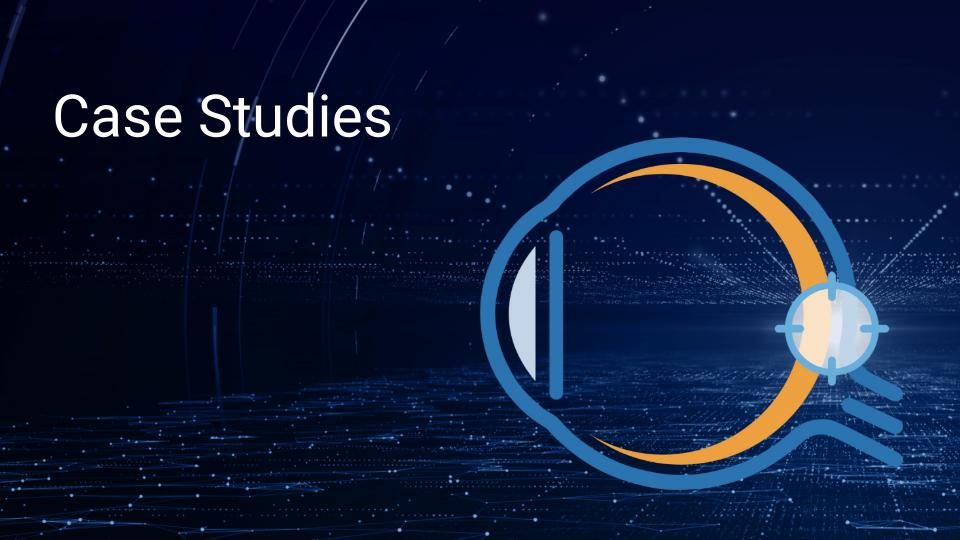
Case Studies
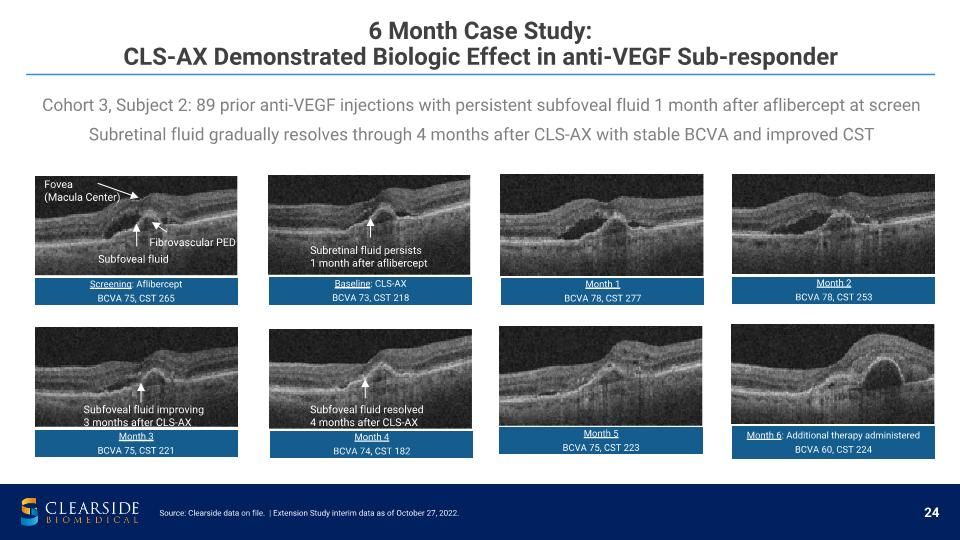
Cohort 3, Subject 2: 89 prior anti-VEGF injections with persistent subfoveal fluid 1 month after aflibercept at screen Subretinal fluid gradually resolves through 4 months after CLS-AX with stable BCVA and improved CST 6 Month Case Study: �CLS-AX Demonstrated Biologic Effect in anti-VEGF Sub-responder Screening: Aflibercept BCVA 75, CST 265 Baseline: CLS-AX BCVA 73, CST 218 Month 1 BCVA 78, CST 277 Month 2 BCVA 78, CST 253 Month 3 BCVA 75, CST 221 Month 4 BCVA 74, CST 182 Month 5 BCVA 75, CST 223 Month 6: Additional therapy administered BCVA 60, CST 224 Subretinal fluid persists 1 month after aflibercept Subfoveal fluid resolved 4 months after CLS-AX Subfoveal fluid improving 3 months after CLS-AX Subfoveal fluid Fibrovascular PED Fovea (Macula Center) Source: Clearside data on file. | Extension Study interim data as of October 27, 2022.
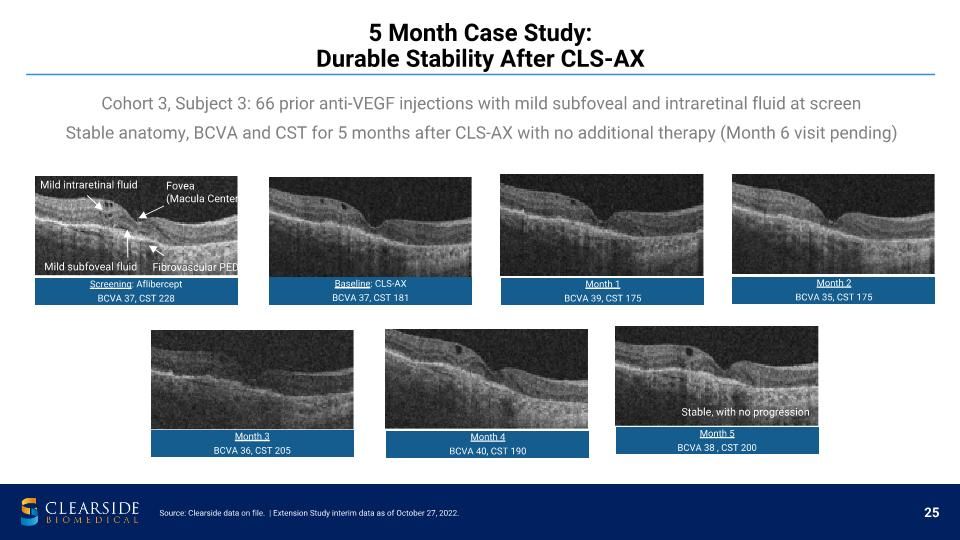
Cohort 3, Subject 3: 66 prior anti-VEGF injections with mild subfoveal and intraretinal fluid at screen Stable anatomy, BCVA and CST for 5 months after CLS-AX with no additional therapy (Month 6 visit pending) 5 Month Case Study: �Durable Stability After CLS-AX Screening: Aflibercept BCVA 37, CST 228 Baseline: CLS-AX BCVA 37, CST 181 Month 1 BCVA 39, CST 175 Month 2 BCVA 35, CST 175 Month 3 BCVA 36, CST 205 Month 4 BCVA 40, CST 190 Month 5 BCVA 38 , CST 200 Mild subfoveal fluid Fibrovascular PED Fovea (Macula Center) Stable, with no progression Mild intraretinal fluid Source: Clearside data on file. | Extension Study interim data as of October 27, 2022.

6 Month Case Study: �Durable Stability After CLS-AX Cohort 3, Subject 4: 15 prior anti-VEGF injections with mild subfoveal fluid at screen Stable anatomy, BCVA and CST for 6 months after CLS-AX with no additional therapy Fovea (Macula Center) Stable, with no progression Screening: Aflibercept BCVA 42, CST 194 Baseline: CLS-AX BCVA 45, CST 175 Month 3 BCVA 45, CST 196 Month 6: BCVA 46 CST 194 Mild subfoveal fluid Fibrovascular PED Fovea (Macula Center) Stable, with no progression Source: Clearside data on file. | Extension Study interim data as of October 27, 2022.
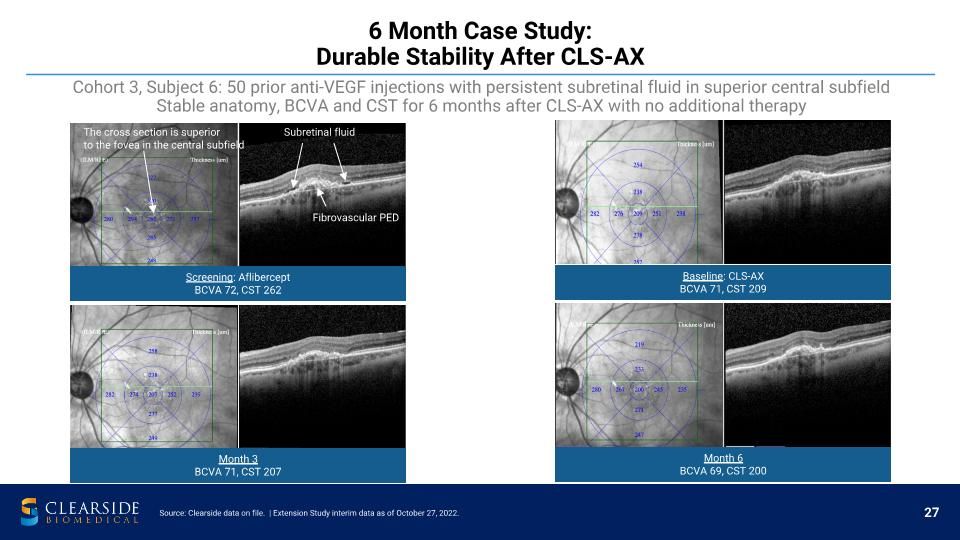
6 Month Case Study: �Durable Stability After CLS-AX Screening: Aflibercept BCVA 72, CST 262 Month 3 BCVA 71, CST 207 Baseline: CLS-AX BCVA 71, CST 209 Month 6 BCVA 69, CST 200 Subretinal fluid Fibrovascular PED The cross section is superior to the fovea in the central subfield Cohort 3, Subject 6: 50 prior anti-VEGF injections with persistent subretinal fluid in superior central subfield Stable anatomy, BCVA and CST for 6 months after CLS-AX with no additional therapy Source: Clearside data on file. | Extension Study interim data as of October 27, 2022.
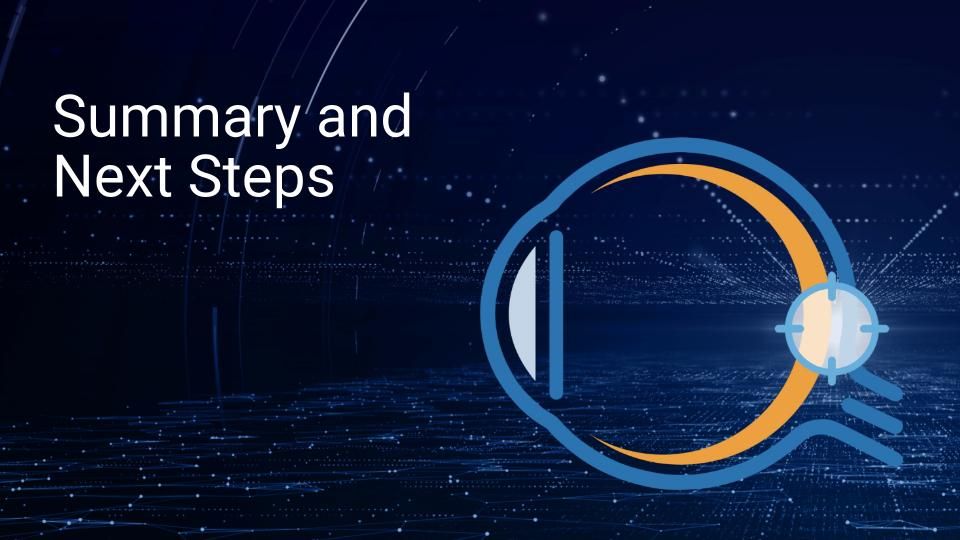
Summary and Next Steps
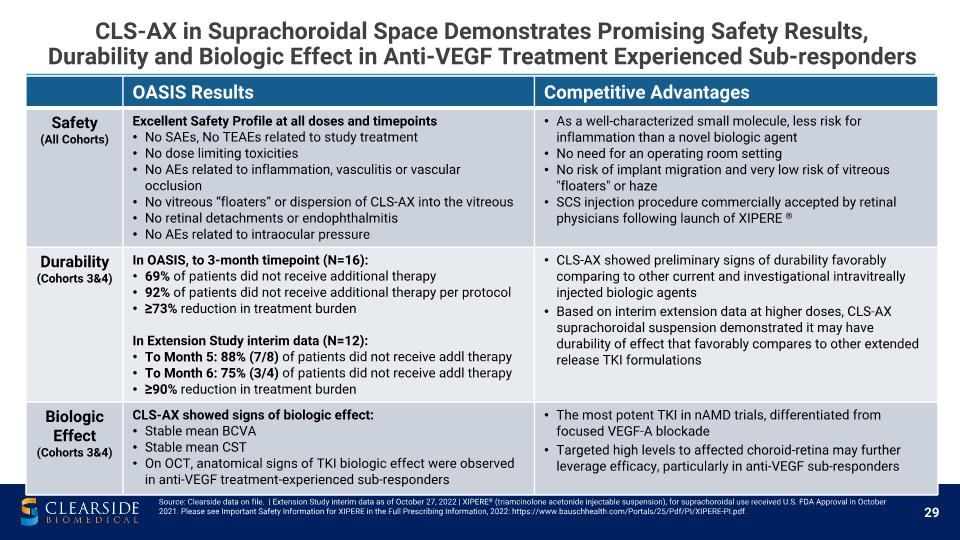
OASIS Results Competitive Advantages Safety (All Cohorts) Excellent Safety Profile at all doses and timepoints No SAEs, No TEAEs related to study treatment No dose limiting toxicities No AEs related to inflammation, vasculitis or vascular occlusion No vitreous “floaters” or dispersion of CLS-AX into the vitreous No retinal detachments or endophthalmitis No AEs related to intraocular pressure As a well-characterized small molecule, less risk for inflammation than a novel biologic agent No need for an operating room setting No risk of implant migration and very low risk of vitreous "floaters" or haze SCS injection procedure commercially accepted by retinal physicians following launch of XIPERE® Durability (Cohorts 3&4) In OASIS, to 3-month timepoint (N=16): 69% of patients did not receive additional therapy 92% of patients did not receive additional therapy per protocol ≥73% reduction in treatment burden In Extension Study interim data (N=12): To Month 5: 88% (7/8) of patients did not receive addl therapy To Month 6: 75% (3/4) of patients did not receive addl therapy ≥90% reduction in treatment burden CLS-AX showed preliminary signs of durability favorably comparing to other current and investigational intravitreally injected biologic agents Based on interim extension data at higher doses, CLS-AX suprachoroidal suspension demonstrated it may have durability of effect that favorably compares to other extended release TKI formulations Biologic Effect (Cohorts 3&4) CLS-AX showed signs of biologic effect: Stable mean BCVA Stable mean CST On OCT, anatomical signs of TKI biologic effect were observed in anti-VEGF treatment-experienced sub-responders The most potent TKI in nAMD trials, differentiated from focused VEGF-A blockade Targeted high levels to affected choroid-retina may further leverage efficacy, particularly in anti-VEGF sub-responders CLS-AX in Suprachoroidal Space Demonstrates Promising Safety Results, Durability and Biologic Effect in Anti-VEGF Treatment Experienced Sub-responders Source: Clearside data on file. | Extension Study interim data as of October 27, 2022 | XIPERE® (triamcinolone acetonide injectable suspension), for suprachoroidal use received U.S. FDA Approval in October 2021. Please see Important Safety Information for XIPERE in the Full Prescribing Information, 2022: https://www.bauschhealth.com/Portals/25/Pdf/PI/XIPERE-PI.pdf.
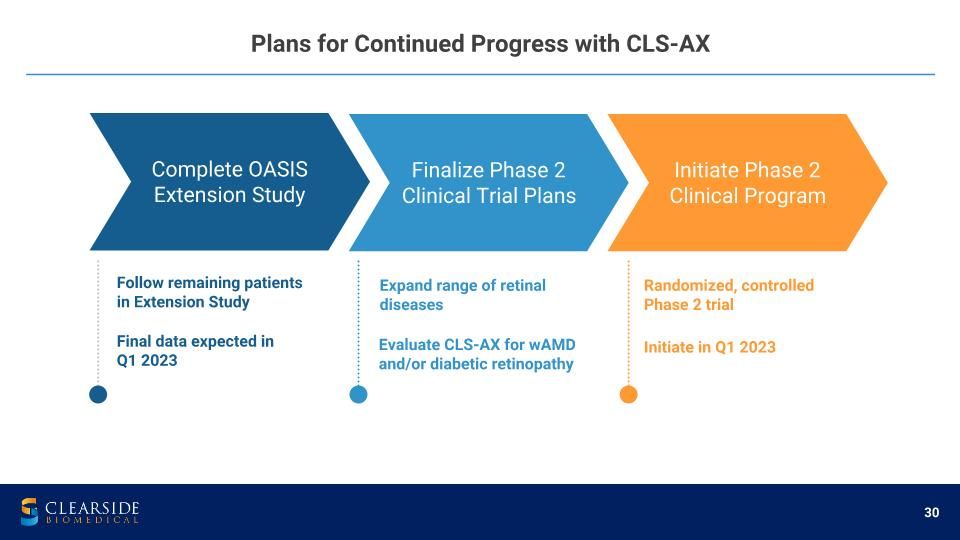
Plans for Continued Progress with CLS-AX Complete OASIS Extension Study Finalize Phase 2 Clinical Trial Plans Initiate Phase 2 Clinical Program Follow remaining patients in Extension Study Initiate in Q1 2023 Evaluate CLS-AX for wAMD and/or diabetic retinopathy Final data expected in �Q1 2023 Expand range of retinal diseases Randomized, controlled Phase 2 trial
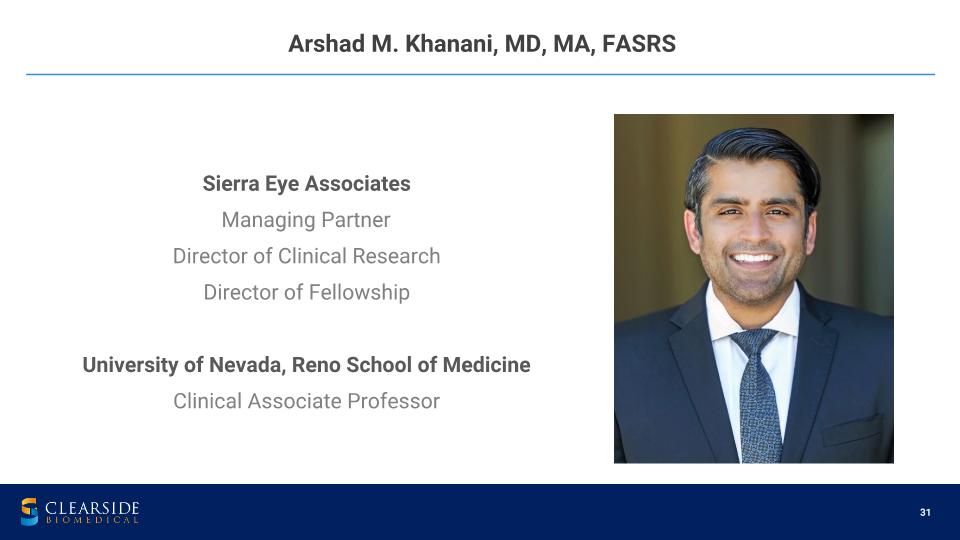
Sierra Eye Associates Managing Partner Director of Clinical Research Director of Fellowship University of Nevada, Reno School of Medicine Clinical Associate Professor Arshad M. Khanani, MD, MA, FASRS
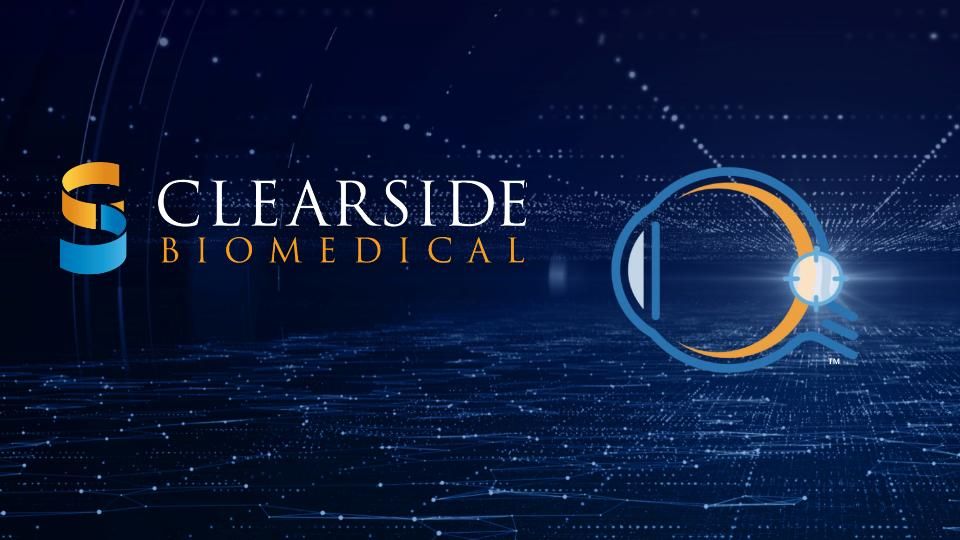
TM
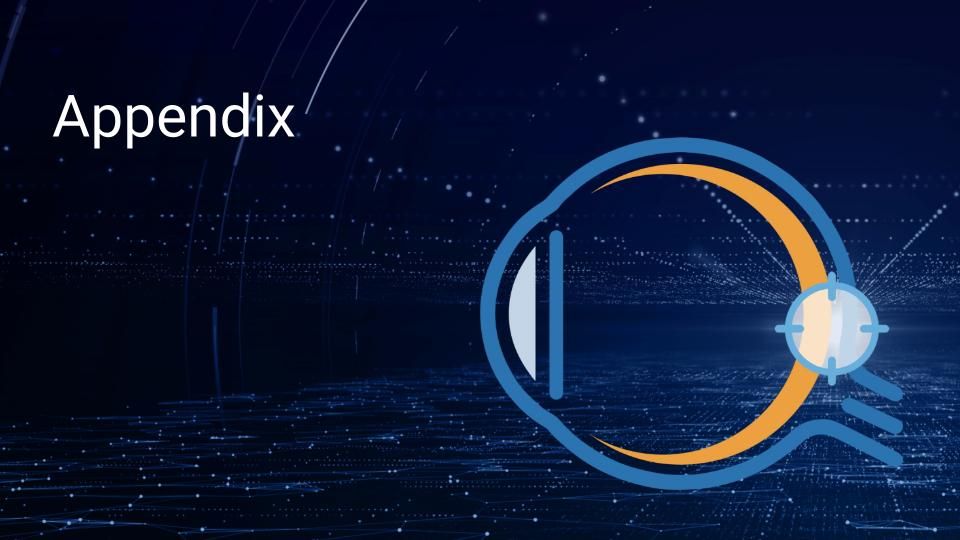
Appendix
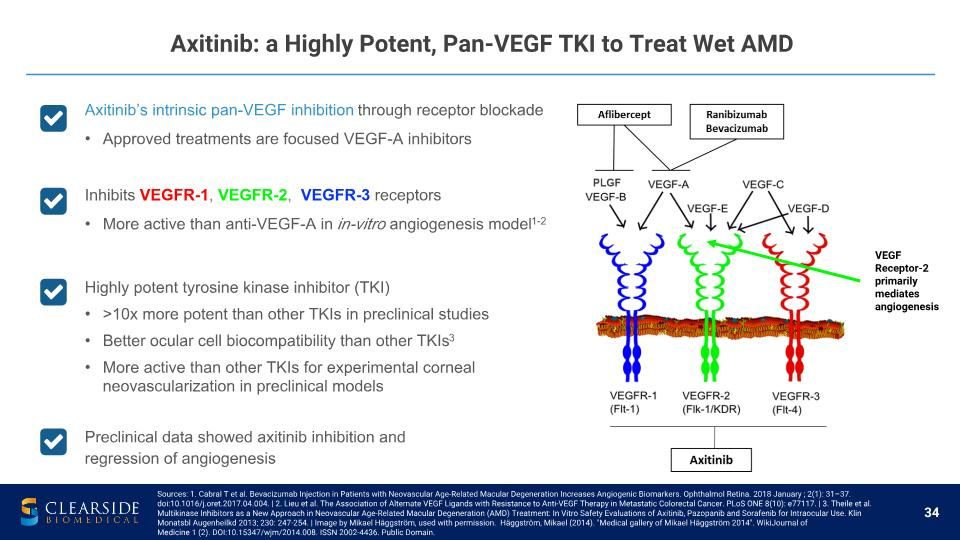
Sources: 1. Cabral T et al. Bevacizumab Injection in Patients with Neovascular Age-Related Macular Degeneration Increases Angiogenic Biomarkers. Ophthalmol Retina. 2018 January ; 2(1): 31–37. doi:10.1016/j.oret.2017.04.004. | 2. Lieu et al. The Association of Alternate VEGF Ligands with Resistance to Anti-VEGF Therapy in Metastatic Colorectal Cancer. PLoS ONE 8(10): e77117. | 3. Theile et al. Multikinase Inhibitors as a New Approach in Neovascular Age-Related Macular Degeneration (AMD) Treatment: In Vitro Safety Evaluations of Axitinib, Pazopanib and Sorafenib for Intraocular Use. Klin Monatsbl Augenheilkd 2013; 230: 247-254. | Image by Mikael Häggström, used with permission. Häggström, Mikael (2014). "Medical gallery of Mikael Häggström 2014". WikiJournal of Medicine 1 (2). DOI:10.15347/wjm/2014.008. ISSN 2002-4436. Public Domain. Axitinib’s intrinsic pan-VEGF inhibition through receptor blockade Approved treatments are focused VEGF-A inhibitors Inhibits VEGFR-1, VEGFR-2, VEGFR-3 receptors More active than anti-VEGF-A in in-vitro angiogenesis model1-2 Highly potent tyrosine kinase inhibitor (TKI) >10x more potent than other TKIs in preclinical studies Better ocular cell biocompatibility than other TKIs3 More active than other TKIs for experimental corneal neovascularization in preclinical models Preclinical data showed axitinib inhibition and regression of angiogenesis VEGF Receptor-2 primarily mediates angiogenesis Axitinib: a Highly Potent, Pan-VEGF TKI to Treat Wet AMD
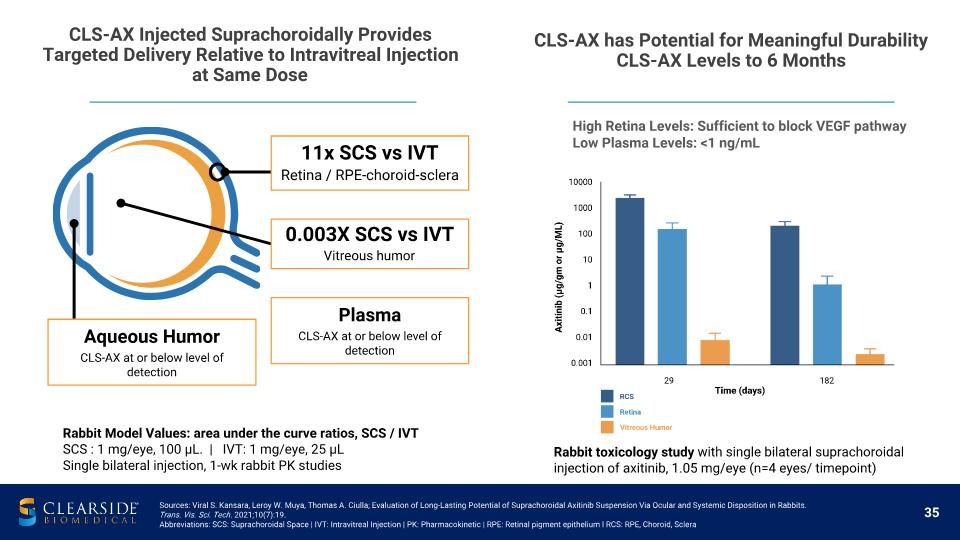
Plasma CLS-AX at or below level of detection Rabbit Model Values: area under the curve ratios, SCS / IVT SCS : 1 mg/eye, 100 µL. | IVT: 1 mg/eye, 25 µL Single bilateral injection, 1-wk rabbit PK studies High Retina Levels: Sufficient to block VEGF pathway Low Plasma Levels: <1 ng/mL 11x SCS vs IVT Retina / RPE-choroid-sclera 0.003X SCS vs IVT Vitreous humor Aqueous Humor CLS-AX at or below level of detection Rabbit toxicology study with single bilateral suprachoroidal injection of axitinib, 1.05 mg/eye (n=4 eyes/ timepoint) Sources: Viral S. Kansara, Leroy W. Muya, Thomas A. Ciulla; Evaluation of Long-Lasting Potential of Suprachoroidal Axitinib Suspension Via Ocular and Systemic Disposition in Rabbits. Trans. Vis. Sci. Tech. 2021;10(7):19. Abbreviations: SCS: Suprachoroidal Space | IVT: Intravitreal Injection | PK: Pharmacokinetic | RPE: Retinal pigment epithelium l RCS: RPE, Choroid, Sclera CLS-AX has Potential for Meaningful Durability CLS-AX Levels to 6 Months CLS-AX Injected Suprachoroidally Provides Targeted Delivery Relative to Intravitreal Injection at Same Dose
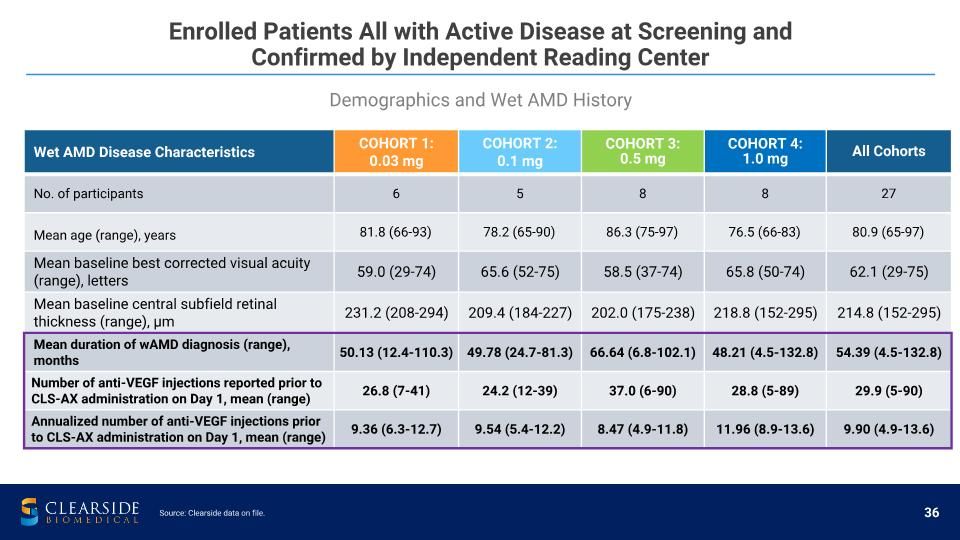
Wet AMD Disease Characteristics COHORT 1: 0.03 mg COHORT 2: 0.1 mg COHORT 3: 0.5 mg COHORT 4: 1.0 mg All Cohorts No. of participants 6 5 8 8 27 Mean age (range), years 81.8 (66-93) 78.2 (65-90) 86.3 (75-97) 76.5 (66-83) 80.9 (65-97) Mean baseline best corrected visual acuity (range), letters 59.0 (29-74) 65.6 (52-75) 58.5 (37-74) 65.8 (50-74) 62.1 (29-75) Mean baseline central subfield retinal thickness (range), µm 231.2 (208-294) 209.4 (184-227) 202.0 (175-238) 218.8 (152-295) 214.8 (152-295) Mean duration of wAMD diagnosis (range), months 50.13 (12.4-110.3) 49.78 (24.7-81.3) 66.64 (6.8-102.1) 48.21 (4.5-132.8) 54.39 (4.5-132.8) Number of anti-VEGF injections reported prior to CLS-AX administration on Day 1, mean (range) 26.8 (7-41) 24.2 (12-39) 37.0 (6-90) 28.8 (5-89) 29.9 (5-90) Annualized number of anti-VEGF injections prior to CLS-AX administration on Day 1, mean (range) 9.36 (6.3-12.7) 9.54 (5.4-12.2) 8.47 (4.9-11.8) 11.96 (8.9-13.6) 9.90 (4.9-13.6) Demographics and Wet AMD History Enrolled Patients All with Active Disease at Screening and �Confirmed by Independent Reading Center Source: Clearside data on file.
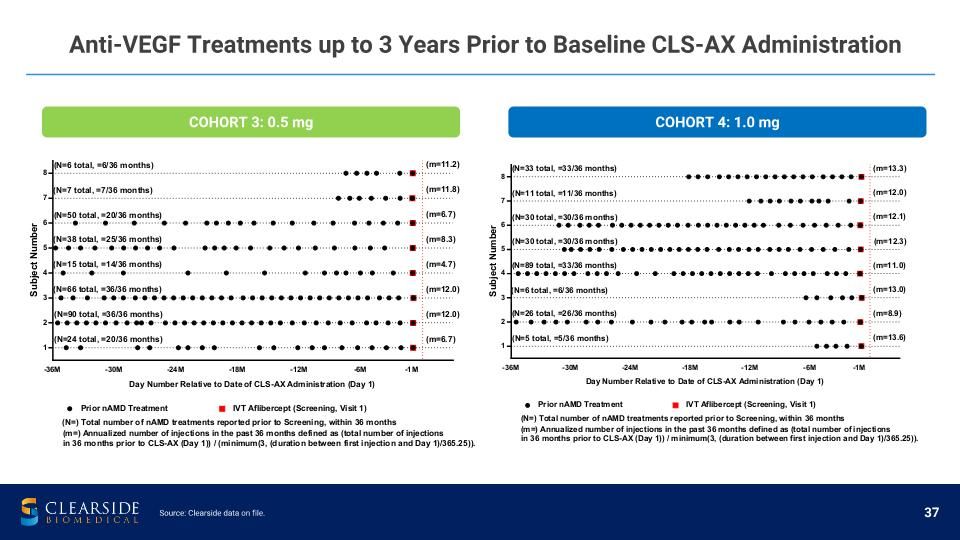
COHORT 3: 0.5 mg COHORT 4: 1.0 mg Source: Clearside data on file. Anti-VEGF Treatments up to 3 Years Prior to Baseline CLS-AX Administration
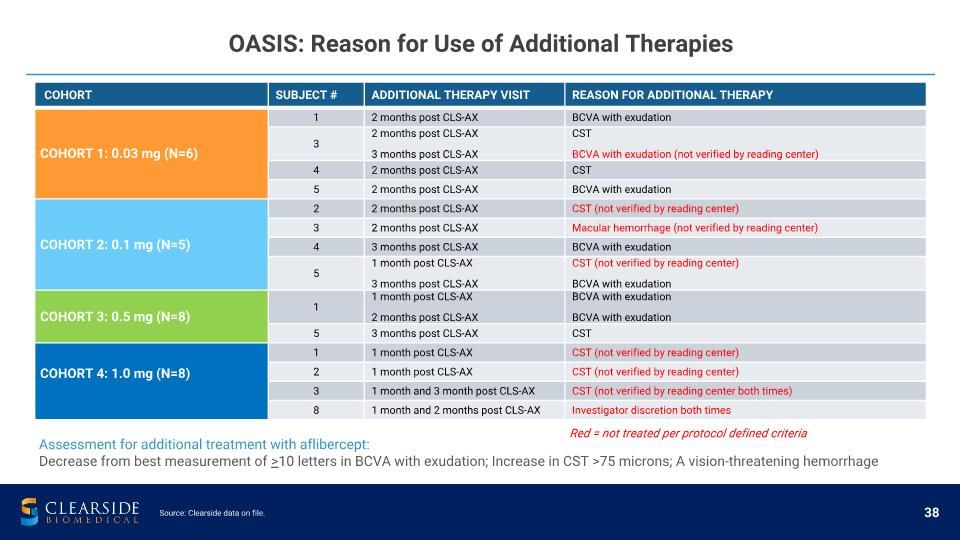
OASIS: Reason for Use of Additional Therapies COHORT SUBJECT # ADDITIONAL THERAPY VISIT REASON FOR ADDITIONAL THERAPY COHORT 1: 0.03 mg (N=6) 1 2 months post CLS-AX BCVA with exudation 3 2 months post CLS-AX 3 months post CLS-AX CST BCVA with exudation (not verified by reading center) 4 2 months post CLS-AX CST 5 2 months post CLS-AX BCVA with exudation COHORT 2: 0.1 mg (N=5) 2 2 months post CLS-AX CST (not verified by reading center) Cohort 2: 0.10 mg (N=5) 3 2 months post CLS-AX Macular hemorrhage (not verified by reading center) 4 3 months post CLS-AX BCVA with exudation 5 1 month post CLS-AX 3 months post CLS-AX CST (not verified by reading center) BCVA with exudation COHORT 3: 0.5 mg (N=8) 1 1 month post CLS-AX 2 months post CLS-AX BCVA with exudation BCVA with exudation 5 3 months post CLS-AX CST COHORT 4: 1.0 mg (N=8) 1 1 month post CLS-AX CST (not verified by reading center) 2 1 month post CLS-AX CST (not verified by reading center) 3 1 month and 3 month post CLS-AX CST (not verified by reading center both times) 8 1 month and 2 months post CLS-AX Investigator discretion both times Assessment for additional treatment with aflibercept: Decrease from best measurement of >10 letters in BCVA with exudation; Increase in CST >75 microns; A vision-threatening hemorrhage Source: Clearside data on file. Red = not treated per protocol defined criteria
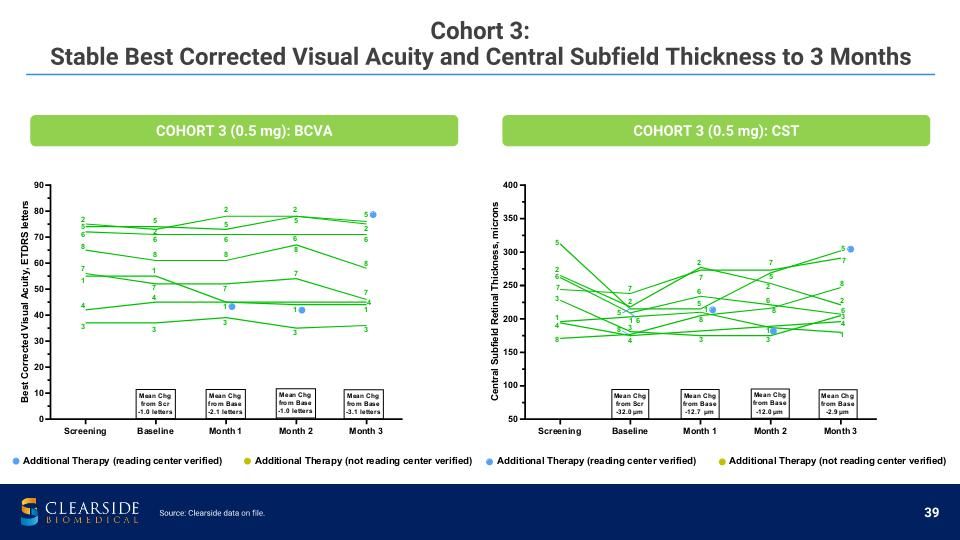
COHORT 3 (0.5 mg): BCVA COHORT 3 (0.5 mg): CST Source: Clearside data on file. Cohort 3: �Stable Best Corrected Visual Acuity and Central Subfield Thickness to 3 Months
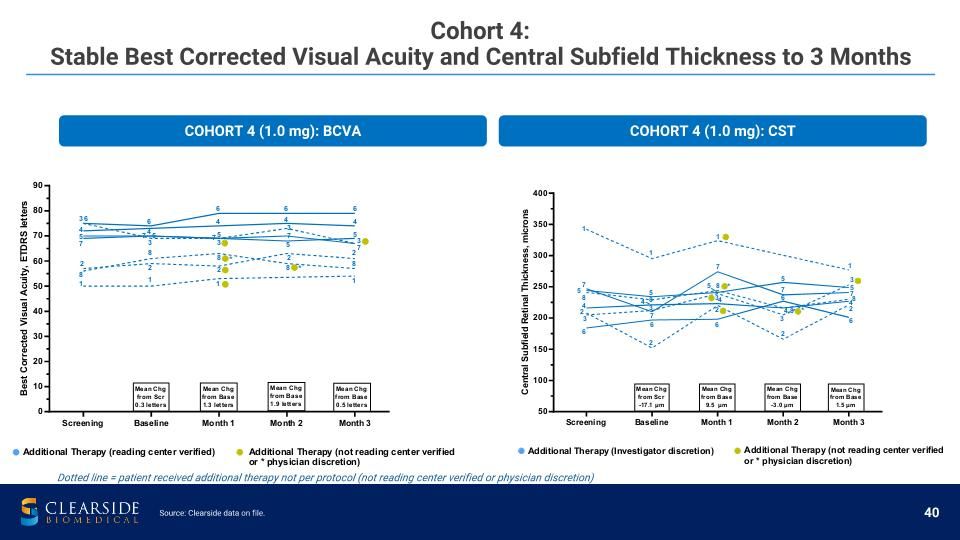
COHORT 4 (1.0 mg): CST COHORT 4 (1.0 mg): BCVA Source: Clearside data on file. Dotted line = patient received additional therapy not per protocol (not reading center verified or physician discretion) Cohort 4: �Stable Best Corrected Visual Acuity and Central Subfield Thickness to 3 Months

Wet AMD Disease Characteristics COHORT 2: 0.10 mg COHORT 3: 0.50 mg COHORT 4: 1.0 mg All Cohorts No. of participants 2 7 5 14 Mean age (range), years 74.0 (70-78) 87.9 (81-97) 79.6 (74-83) 82.9 (70-97) Mean baseline best corrected visual acuity (range), letters 60.0 (52-68) 59.0 (37-74) 71.2 (69-74) 63.5 (37-74) Mean baseline central subfield retinal thickness (range), µm 213.5 (200-227) 201.9 (175-238) 214.8 (197-234) 208.1 (175-238) Mean duration of wAMD diagnosis (range), months 44.30 (33.9-54.7) 67.29 (6.8-102.1) 36.42 (6.1-103.4) 52.98 (6.1-103.4) Number of anti-VEGF injections reported prior to CLS-AX administration on Day 1, mean (range) 23.0 (12-34) 38.9 (6-90) 33.2 (6-89) 34.6 (6-90) Annualized number of anti-VEGF injections prior to Enrollment, mean (range) 8.81 (5.4-12.2) 8.84 (4.9-11.9) 12.01 (10.5-13.1) 9.97 (4.9-13.1) Extension Study: Demographics and Wet AMD History Source: Clearside data on file. | Extension Study interim data as of October 27, 2022. Cohort 2 data calculated with number of patients with available data. Cohorts 3 & 4 data calculated with number of participants currently enrolled. Interim Data
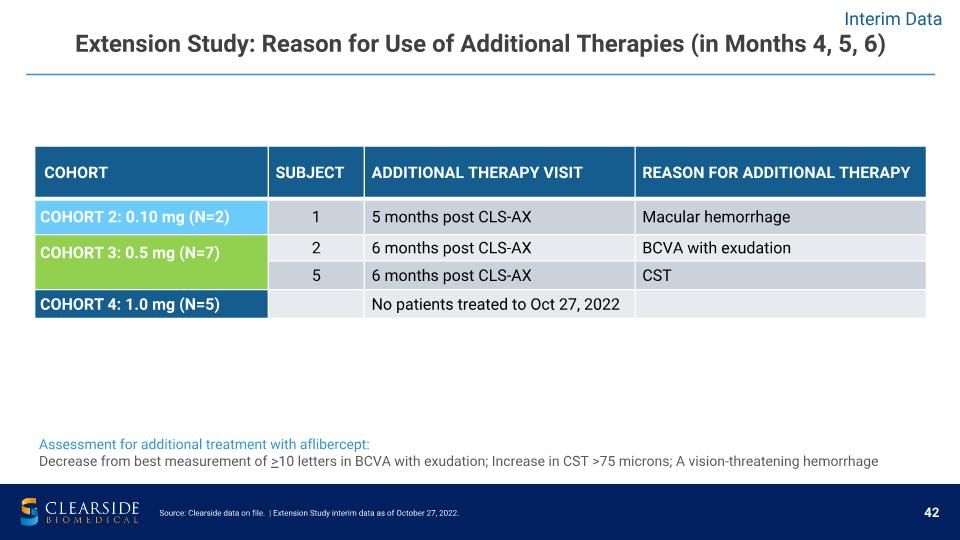
Extension Study: Reason for Use of Additional Therapies (in Months 4, 5, 6) COHORT SUBJECT ADDITIONAL THERAPY VISIT REASON FOR ADDITIONAL THERAPY COHORT 2: 0.10 mg (N=2) 1 5 months post CLS-AX Macular hemorrhage COHORT 3: 0.5 mg (N=7) 2 6 months post CLS-AX BCVA with exudation 5 6 months post CLS-AX CST COHORT 4: 1.0 mg (N=5) No patients treated to Oct 27, 2022 Source: Clearside data on file. | Extension Study interim data as of October 27, 2022. Assessment for additional treatment with aflibercept: Decrease from best measurement of >10 letters in BCVA with exudation; Increase in CST >75 microns; A vision-threatening hemorrhage Interim Data
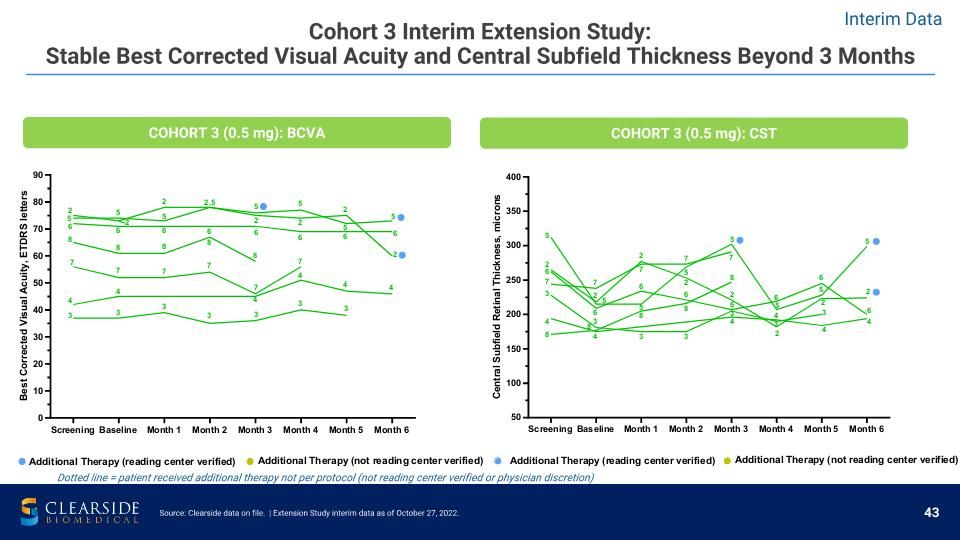
Cohort 3 Interim Extension Study: �Stable Best Corrected Visual Acuity and Central Subfield Thickness Beyond 3 Months COHORT 3 (0.5 mg): BCVA COHORT 3 (0.5 mg): CST Source: Clearside data on file. | Extension Study interim data as of October 27, 2022. Dotted line = patient received additional therapy not per protocol (not reading center verified or physician discretion) Interim Data
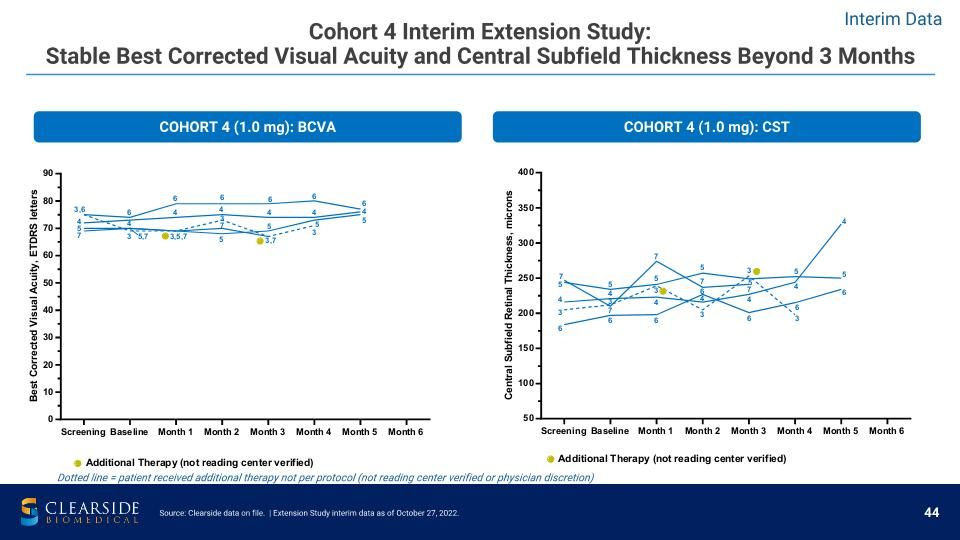
COHORT 4 (1.0 mg): CST COHORT 4 (1.0 mg): BCVA Source: Clearside data on file. | Extension Study interim data as of October 27, 2022. Dotted line = patient received additional therapy not per protocol (not reading center verified or physician discretion) Interim Data Cohort 4 Interim Extension Study: �Stable Best Corrected Visual Acuity and Central Subfield Thickness Beyond 3 Months
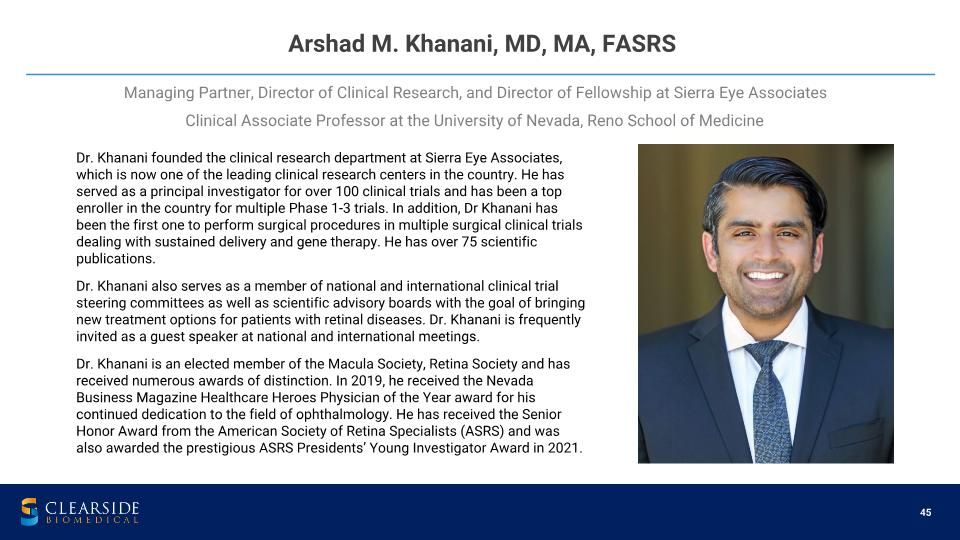
Dr. Khanani founded the clinical research department at Sierra Eye Associates, which is now one of the leading clinical research centers in the country. He has served as a principal investigator for over 100 clinical trials and has been a top enroller in the country for multiple Phase 1-3 trials. In addition, Dr Khanani has been the first one to perform surgical procedures in multiple surgical clinical trials dealing with sustained delivery and gene therapy. He has over 75 scientific publications. Dr. Khanani also serves as a member of national and international clinical trial steering committees as well as scientific advisory boards with the goal of bringing new treatment options for patients with retinal diseases. Dr. Khanani is frequently invited as a guest speaker at national and international meetings. Dr. Khanani is an elected member of the Macula Society, Retina Society and has received numerous awards of distinction. In 2019, he received the Nevada Business Magazine Healthcare Heroes Physician of the Year award for his continued dedication to the field of ophthalmology. He has received the Senior Honor Award from the American Society of Retina Specialists (ASRS) and was also awarded the prestigious ASRS Presidents’ Young Investigator Award in 2021. Managing Partner, Director of Clinical Research, and Director of Fellowship at Sierra Eye Associates Clinical Associate Professor at the University of Nevada, Reno School of Medicine Arshad M. Khanani, MD, MA, FASRS












































